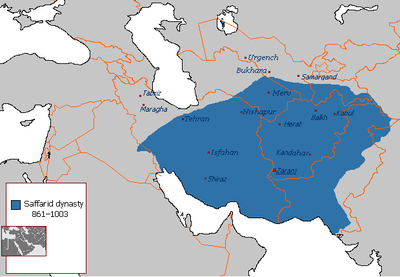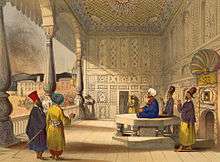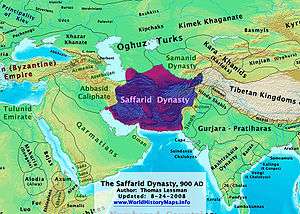Saffarid dynasty
The Saffarid dynasty (Persian: صفاریان) was a Sunni Persian[3] dynasty from Sistan that ruled over parts of eastern Iran, with its capital at Zaranj (a city now in southwestern Afghanistan),[4][5] from 861 to 1003.[6] One of the first indigenous Persian dynasties to emerge after the Islamic conquest,[7][8][9][10][11][12][13] the Saffarid dynasty was part of the Iranian Intermezzo. The dynasty's founder was Ya'qub bin Laith as-Saffar, who was born in 840 in a small town called Karnin (Qarnin), which was located east of Zaranj and west of Bost, in what is now Afghanistan. A native of Sistan and a local ayyār, Ya'qub worked as a coppersmith (ṣaffār) before becoming a warlord. He seized control of the Sistan region and began conquering most of Iran and Afghanistan, as well as parts of Pakistan, Tajikistan and Uzbekistan.
Saffarid dynasty صفاریان | |||||||||||||
|---|---|---|---|---|---|---|---|---|---|---|---|---|---|
| 861–1003 | |||||||||||||
 Saffarid dynasty at its greatest extent under Ya'qub ibn al-Layth al-Saffar | |||||||||||||
| Capital | Zaranj | ||||||||||||
| Common languages | Persian (mother tongue)[1][2] | ||||||||||||
| Religion | Sunni Islam | ||||||||||||
| Government | Monarchy | ||||||||||||
| Emir | |||||||||||||
• 861–879 | Ya'qub bin Laith as-Saffar | ||||||||||||
• 963–1002 | Khalaf I | ||||||||||||
| Historical era | Medieval | ||||||||||||
• Established | 861 | ||||||||||||
• Disestablished | 1003 | ||||||||||||
| |||||||||||||
The Saffarids used their capital Zaranj as a base for an aggressive expansion eastward and westward. They first invaded the areas south of the Hindu Kush, and then overthrew the Persian Tahirid dynasty, annexing Khorasan in 873. By the time of Ya'qub's death, he had conquered the Kabul Valley, Sindh, Tocharistan, Makran (Balochistan), Kerman, Fars, Khorasan, and nearly reached Baghdad but then suffered a defeat by the Abbasids.[6]
The Saffarid dynasty did not last long after Ya'qub's death. His brother and successor, Amr bin Laith, was defeated at the Battle of Balkh against Ismail Samani in 900. Amr bin Laith was forced to surrender most of his territories to the new rulers. The Saffarids were subsequently confined to their heartland of Sistan, with their role reduced to that of vassals of the Samanids and their successors.
Founding
The dynasty began with Ya'qub ibn al-Layth al-Saffar (Ya'qub, son of Layth, the Coppersmith), a coppersmith who moved to the city of Zaranj. He left work to become an Ayyar and eventually got the power to act as an independent ruler. From his capital Zaranj he moved east into al-Rukhkhadj and Zamindawar followed by Zunbil and Kabul by 865. He then invaded Bamyan, Balkh, Badghis, and Ghor. In the name of Islam, he conquered these territories which were ruled mostly by Buddhist tribal chiefs. He took vast amounts of plunder and slaves from this campaign.[15] Nancy Dupree in her book An Historical Guide to Afghanistan describes Yaqub's conquests as such:
Arab armies carrying the banner of Islam came out of the west to defeat the Sasanians in 642 and then they marched with confidence to the east. On the western periphery of the Afghan area the princes of Herat and Sistan gave way to rule by Arab governors but in the east, in the mountains, cities submitted only to rise in revolt and the hastily converted returned to their old beliefs once the armies passed. The harshness and avariciousness of Arab rule produced such unrest, however, that once the waning power of the Caliphate became apparent, native rulers once again established themselves independent. Among these Saffarids of Sistan shone briefly in the Afghan area. The fanatic founder of this dynasty, the coppersmith’s apprentice Yaqub ibn Layth Saffari, came forth from his capital at Zaranj in 870 and marched through Bost, Kandahar, Ghazni, Kabul, Bamyan, Balkh and Herat, conquering in the name of Islam.[16]
— Nancy Dupree, 1971
Expansion
The Tahirid city of Herat was captured in 870 and his campaign in the Badghis region led to the capture of Kharidjites which later formed the Djash al-Shurat contingent in his army. Ya'qub then turned his focus to the west and began attacks on Khorasan, Khuzestan, Kerman (Southeastern Iran) and Fars (southwestern Iran).[17] The Saffarids then seized Khuzestan (southwestern Iran) and parts of southern Iraq, and in 876 came close to overthrowing the Abbasids, whose army was able to turn them back only within a few days' march from Baghdad. These incursions, however, forced the Abbasid caliphate to recognize Ya'qub as governor of Sistan, Fars and Kerman, and Saffarids were even offered key posts in Baghdad.[18]
Decline
In 901, Amr Saffari was defeated at the battle of Balkh by the Samanids, and they lost Khorasan to them.The Saffarids were reduced to the provinces of Fars, Kerman and Sistan. Under Tahir ibn Muhammad ibn Amr (901-908), the dynasty fought the Abbasids for the possession of Fars and keep its control over the province. In 908, begin a civil war between Tahhir and the pretender al-Laith b. 'Ali in Sistan. In the next years, the governor of Fars, Sebük-eri defeat to the Abbasids.In 912, the Samanids finally expelled the Saffarids from Sistan. Sistan passed briefly to Abbasid control, but become independent again under the Saffarid Abu Ja'far Ahmad ibn Muhammad, but the dynasty was now a minor power isolated in Sistan.
In 1002, Mahmud of Ghazni invaded Sistan, dethroned Khalaf I and finally ended the Saffarid dynasty.[19]
Culture
The Saffarids gave great care to the Persian culture. Under their rule, the eastern Islamic world witnessed the emergence of prominent Persian poets such as Fayrouz Mashriqi, Abu Salik al-Jirjani, and Muhammad bin Wasif al-Sistani, who was a court poet.[20]
In the later 9th century, the Saffarids gave impetus to a renaissance of New Persian literature and culture. Following Ya'qub's conquest of Herat, some poets chose to celebrate his victory in Arabic, whereupon Ya'qub requested his secretary, Muhammad bin Wasif al-Sistani, to compose those verses in Persian.[21]
From silver mines in the Panjshir Valley, the Saffarids were able to mint silver coins.[22]
Rulers of the Saffarid dynasty
Part of a series on the |
||||||||||||||||||||||||||||||||||||||
|---|---|---|---|---|---|---|---|---|---|---|---|---|---|---|---|---|---|---|---|---|---|---|---|---|---|---|---|---|---|---|---|---|---|---|---|---|---|---|
| History of Afghanistan | ||||||||||||||||||||||||||||||||||||||
 | ||||||||||||||||||||||||||||||||||||||
| Timeline | ||||||||||||||||||||||||||||||||||||||
|
Ancient
|
||||||||||||||||||||||||||||||||||||||
|
Medieval
|
||||||||||||||||||||||||||||||||||||||
|
Modern
|
||||||||||||||||||||||||||||||||||||||
| Related historical names of the region | ||||||||||||||||||||||||||||||||||||||
| ||||||||||||||||||||||||||||||||||||||
| Titular Name | Personal Name | Reign | |
|---|---|---|---|
| Independence from the Abbasid Caliphate. | |||
| Amir أمیر al-Saffar coppersmith الصفار |
Ya'qub ibn Layth یعقوب بن اللیث |
861-879 CE | |
| Amir أمیر |
Amr ibn al-Layth عمرو بن اللیث |
879-901 CE | |
| Amir أمیر Abul-Hasan أبو الحسن |
Tahir ibn Muhammad ibn Amr طاھر بن محمد بن عمرو co-ruler Ya'qub ibn Muhammad ibn Amr |
901-908 CE | |
| Amir أمیر |
al-Layth ibn 'Ali اللیث بن علي |
908-910 CE | |
| Amir أمیر |
Muhammad ibn 'Ali محمد بن علي |
910-911 CE | |
| Amir أمیر |
Al-Mu'addal ibn 'Ali المعضل ابن علي |
911 CE | |
| Amir أمیر Abu Hafs ابو حفص |
Amr ibn Ya'qub ibn Muhammad ibn Amr عمرو بن یعقوب بن محمد بن عمرو |
912-913 CE | |
| Samanid occupation 913-922 CE. | |||
| Amir أمیر Abu Ja'far ابو جعفر |
Ahmed ibn Muhammad ibn Khalaf ibn Layth ibn 'Ali | 922-963 CE | |
| Amir أمیر Wali-ud-Daulah ولي الدولة |
Khalaf ibn Ahmad ibn Muhammad ibn Khalaf ibn al-Layth ibn 'Ali | 963-1002 CE | |
| Conquered by Mahmud ibn Sebuktigin of the Ghaznavid Empire in 1002 CE. | |||
Gallery
 The Saffarid dynasty and its neighbors at its peak in 900 CE
The Saffarid dynasty and its neighbors at its peak in 900 CE Saffarid Soldier
Saffarid Soldier
See also
- Iranian Intermezzo
- Nasrid dynasty (Sistan)
- Mihrabanids
- Samanids
- Ghaznavids
- List of kings of Persia
- List of Sunni Muslim dynasties
References
- "Persian Prose Literature". World Eras. HighBeam Research. 2002. Archived from the original on May 2, 2013. Retrieved September 3, 2012.
Princes, although they were often tutored in Arabic and religious subjects, frequently did not feel as comfortable with the Arabic language and preferred literature in Persian, which was either their mother tongue—as in the case of dynasties such as the Saffarids (861–1003), Samanids (873–1005), and Buyids (945–1055)...
- Robinson, Chase F. (2009). The new Cambridge history of Islam. Vol 1, Sixth to eleventh centuries (1. publ. ed.). Cambridge: Cambridge Univ. Press. p. 345. ISBN 978-0-521-83823-8.
The Tahirids had made scant use of Persian, though the Saffarids used it considerably more. But under the Samanids Persian emerged as a full "edged language of literature and (to a lesser extent) administration. Court patronage was extended to Persian poets, including the great Rudaki (d. c. 940). Meanwhile Arabic continued to be used abundantly, for administration and for scientific, theo logical and philosophical discourse.
- Tor, D. G. (2009). "The Islamization of Central Asia in the Samanid era and the reshaping of the Muslim world". Bulletin of the School of Oriental and African Studies. University of London. 72 (2): 281. doi:10.1017/S0041977X09000524.
The Saffārids were the first of the Persianate dynasties to arise from the remains of the politically moribund ʿAbbāsid caliphate.
- Frye, Richard Nelson; Fisher, William Bayne; Boyle, John Andrew (1975). The Cambridge History of Iran. Cambridge University Press. p. 121. ISBN 0-521-20093-8.
- Stearns, Peter N.; Langer, William Leonard, eds. (2001). The Encyclopedia of World History. Houghton Mifflin. p. 115.
- Bosworth, Clifford Edmund. "Saffarids". Encyclopædia Iranica.
- "Saffarid dynasty". The Oxford Dictionary of the Middle Ages. Oxford University Press. 2010-01-01. doi:10.1093/acref/9780198662624.001.0001. ISBN 9780198662624.
One of the first indigenous Persian dynasties to emerge after the Arab Islamic invasions.
- Savory, Roger M. (1996). "The History of the Saffarids of Sistan and the Maliks of Nimruz (247/861 to 949/1542-3)". Journal of the American Oriental Society.
First, the Saffarid amirs and maliks were rulers of Persian stock who for centuries championed the cause of the underdog against the might of the Abbasid caliphs.
- al Saffar, Ya'kub b. al-Layth; Bosworth, C. E. The Encyclopaedia of Islam. Vol. XI. p. 255.
The provincial Persian Ya'kub, on the other hand, rejoiced in his plebeian origins, denounced the Abbasids as usurpers, and regarded both the caliphs and such governors from aristocratic Arab families as the Tahirids with contempt
- Meisami, Julie Scott; Starkey, Paul (eds.). Encyclopedia of Arabic Literature. Volume 2. p. 674.
Saffarids: A Persian dynasty.....
- Aldosari, Ali. Middle East, Western Asia, and Northern Africa. p. 472.
There were many local Persian dynasties, including the Tahirids, the Saffarids....
- Cannon, Garland Hampton. The Arabic Contributions to the English Language: An Historical Dictionary. p. 288.
Saffarid, the Coppersmith, the epithet of the founder of this Persian dynasty...
- Daftary, Farhad. Historical Dictionary of the Ismailis. p. 51.
The Saffarids, the first Persian dynasty, to challenge the Abbasids...
- Bosworth, C. E. (1995). "Saffarids". In Bosworth, C. E.; van Donzel, E.; Heinrichs, W. P.; Lecomte, G. (eds.). Encyclopedia of Islam. Vol. VIII. Brill. p. 795.
- Dupree, Nancy (1971). "Sites in Perspective (Chapter 3)". An Historical Guide To Afghanistan. Kabul: Afghan Tourist Organization. OCLC 241390.
- "Saffarids". Encyclopedia of Islam. Vol. VIII. p. 795.
- Esposito, John L. (1999). The Oxford History of Islam. Oxford: Oxford University Press. p. 38.
- Bosworth, C. E. (1963). The Ghaznavids 994–1040. Edinburgh University Press. p. 89.
- Bosworth, C. E. (1969). "The Ṭāhirids and Persian Literature". Iran. 7: 104.
- Bosworth, C. E. (1999). "The Tahirids and the Saffarids". In Frye, R. N. (ed.). The Cambridge History of Iran: The period from the Arab Invasion to the Saljuqs. Vol. IV. Cambridge University Press. p. 129.
- "Pandjhir". Encyclopedia of Islam. Vol. VIII. p. 258.
External links
| Wikisource has the text of the 1911 Encyclopædia Britannica article Ṣaffārids. |
- Encyclopædia Iranica Saffarids
